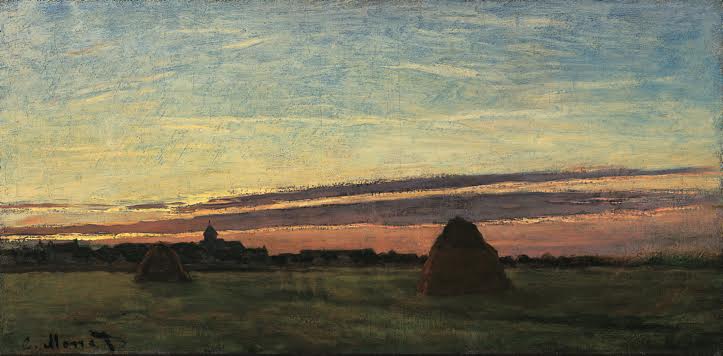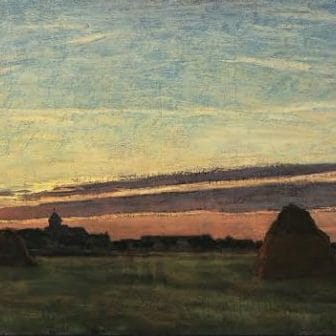
Haystacks at Chailly oil on canvas 1865
SDMA collection
Reflections on Monet
San Diego Museum of Art
Gluck Gallery, San Diego Museum of Art
Through January 21, 2018
Click HERE for more information
Article by Cathy Breslaw
Inside the Gluck Gallery at the San Diego Museum of Art, is a small but powerful collection of mostly impressionistic paintings dating between the late 1800’s and early 1900’s. This intimate, low-lit setting is a perfect place to view three important paintings by Claude Monet, each representing different stages of the artist’s career. The earliest oil painting, Haystacks at Chailly was painted in 1865, towards the beginning of Monet’s painting career, and is thought to be the first of his many ‘haystack’ paintings. As one of the San Diego Museum of Art’s collection, this small painting is a realistic rendering of a landscape by comparison to Monet’s later more ‘loosely’ painted impressionistic works. The gorgeous color palette, a range of blues, purples, pinks, yellows and blues light up the skies while a range of greens, yellows and browns emerge from the ground as grass and fields with hills in the background. The haystack is a point of interest but not central to the composition as in Monet’s later haystack paintings.
Moving on chronologically, Eglise de Varengeville was painted in 1882, and as most of Monet’s paintings was created outdoors on location. Upon observation of the coastal cliffs painted from below, the viewer sees active and energized brushwork in several colors as the artist breaks down the rocks into sections of an array of whites, oranges, yellows, reds, browns and greens. The last of Monet’s three paintings exhibited is Le Bassin des Nympheas created in the latter part of his career in 1904. By this time, Monet was fully into Impressionism, using the play and qualities of light, mixing colors on the canvas with thin visible brushstrokes to create movement, and an open composition while depicting unusual angles of the subject matter. This larger painting, also called The Lily Pond, was painted in his garden at Giverny and is a subject he repeatedly painted in his later years. On loan from the Denver Art Museum, it captures only a small section of a lily pond, focusing in on floating flower pads as well as the water reflections of bushes, brush, and trees on shore. The blue-greens, greens, yellow-greens, pinks, lilacs, whites and yellows are a sea of multi-dimensional brush strokes activating the surfaces of the painting, adding movement and creating a kind of surreal atmosphere. Also in the exhibition is Notre Dame (1900), an oil painting by French artist Maximilien Luce, Late Afternoon, Giverny (1905-1913), an oil painting by American artist Guy Orlando Rose, and an oil painting, The Edge of the Forest( 1887-1892), by American artist Theodore Robinson – all painted in the Impressionistic style.



